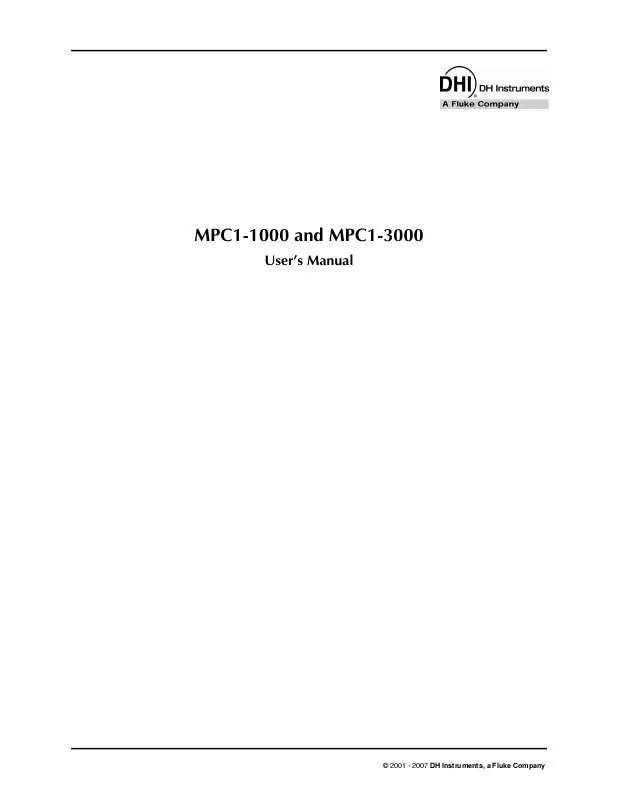User manual FLUKE MPC1-3000
Lastmanuals offers a socially driven service of sharing, storing and searching manuals related to use of hardware and software : user guide, owner's manual, quick start guide, technical datasheets... DON'T FORGET : ALWAYS READ THE USER GUIDE BEFORE BUYING !!!
If this document matches the user guide, instructions manual or user manual, feature sets, schematics you are looking for, download it now. Lastmanuals provides you a fast and easy access to the user manual FLUKE MPC1-3000. We hope that this FLUKE MPC1-3000 user guide will be useful to you.
Lastmanuals help download the user guide FLUKE MPC1-3000.
Manual abstract: user guide FLUKE MPC1-3000
Detailed instructions for use are in the User's Guide.
[. . . ] MPC1-1000 and MPC1-3000
User's Manual
© 2001 - 2007 DH Instruments, a Fluke Company
MPC1-1000 and MPC1-3000 User's Manual
Manual Conventions
(CAUTION) is used in throughout the manual to identify user warnings and cautions. (NOTE) is used throughout the manual to identify operating and applications advice and additional explanations.
High pressure liquids and gases are potentially hazardous. Energy stored in these liquids and gases can be released unexpectedly and with extreme force. High pressure systems should be assembled and operated only by personnel who have been instructed in proper safety practices.
© 1999 - 2007 DH Instruments, a Fluke Company All rights reserved. [. . . ] Close equalization valve (push valve inward). Adjust VV knob until desired pressure is obtained (or until the piston floats when connected to a piston gauge). To continue decreasing pressures, repeat Step .
Page 11
© 2001 - 2007 DH Instruments, a Fluke Company
MPC1-1000 and MPC1-3000 User's Manual
NOTES
© 2001 - 2007 DH Instruments, a Fluke Company
Page 12
MPC1-1000 and MPC1-3000 User's Manual
4. MAINTENANCE AND ADJUSTMENTS
No special maintenance or adjustments are required for the MPC1.
Page 13
© 2001 - 2007 DH Instruments, a Fluke Company
MPC1-1000 and MPC1-3000 User's Manual
NOTES
© 2001 - 2007 DH Instruments, a Fluke Company
Page 14
MPC1-1000 and MPC1-3000 User's Manual
5. TROUBLESHOOTING
5. 1 GENERAL INFORMATION
The MPC1 consists of three valves: a variable volume (VV), a pressure gauge and various tubing and fittings. Several predictable problems can arise while using the instrument and are addressed in this section. It is recommended that whomever performs the following troubleshooting procedures become familiar with the system schematic (see Section 6. 1) including the VV description (see Section 6. 2). For problems not covered in this section, or direct technical assistance and/or for ordering information on replacement components, please contact the Technical Service Department.
5. 2 LEAKS
Pressure leaks are the most common problem found in pressure handling equipment. Normally, the first step is to determine if the leak is within the MPC1 or if it is outside of the unit. To determine if the leak is within the MPC1, you must disconnect the unit at the test connection and plug it. Establish similar conditions under which the leak was observed and determine if the leak is still present. For small leaks, it may be necessary to install an appropriate pressure sensing device at the test port, user discretion required. In some cases, it is useful to perform simple leak checks on the most common outside sources before disconnecting the test system. Leaks inside the MPC1 are unusual unless there has been some disassembly. Because of the close fitting components and short tubing runs, some users may find it beneficial to return the MPC1 to DHI for repair rather than perform the troubleshooting and repair themselves. To do so, contact DHI Technical Service. More than one leak can exist in a system so fixing one does not guarantee a leak tight system. Therefore, continue executing the troubleshooting procedures until all leaks are located and corrected. Since a troubleshooting guide that will cover every conceivable possibility is impractical, the source of your leak may not be shown here.
Page 15
© 2001 - 2007 DH Instruments, a Fluke Company
MPC1-1000 and MPC1-3000 User's Manual
There are four possible leak conditions: · · · · A leak causing a pressure increase when system pressure is above atmosphere A leak causing a pressure decrease when system pressure is above atmosphere A leak causing a pressure increase when system pressure is below atmosphere A leak causing a pressure decrease when system pressure is below atmosphere
A common reaction to a system leak is to close a particular valve more tightly. Although a valve may not have been completely closed, care should be used when attempting to do so. Repeatedly overtightening a valve may result in premature failure. If a procedure requires you to tighten a leaky fitting, there are two precautions that need to be observed. [. . . ] This is due to the compressibility of gases at low pressures which worsens as pressures decrease and volumes increase. Prevent this situation when evaluating the performance of the VV. If pressure cannot be changed through the use of the VV, the problem is with the equalization valve, the VV piston O-ring or the filter connected to the VV rear plate. Confirm that the equalization valve is closed (pushed in). [. . . ]
DISCLAIMER TO DOWNLOAD THE USER GUIDE FLUKE MPC1-3000 Lastmanuals offers a socially driven service of sharing, storing and searching manuals related to use of hardware and software : user guide, owner's manual, quick start guide, technical datasheets...manual FLUKE MPC1-3000


